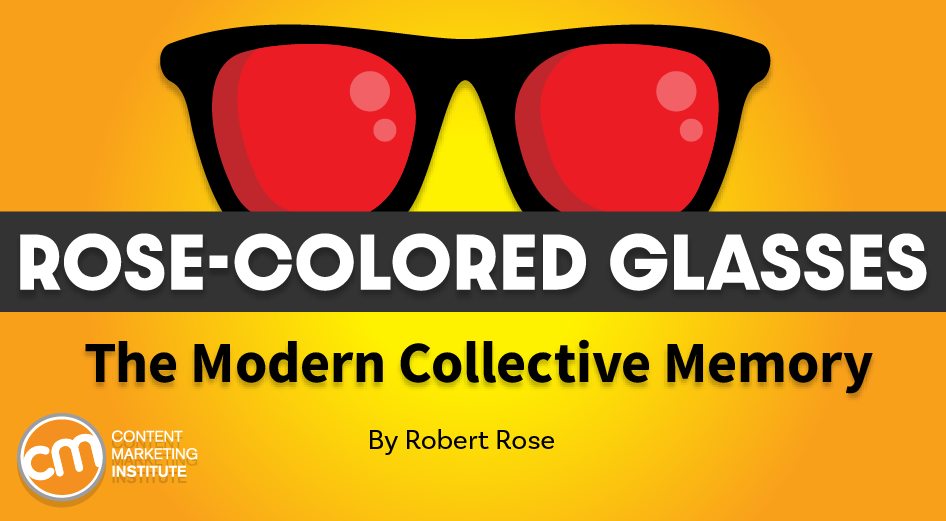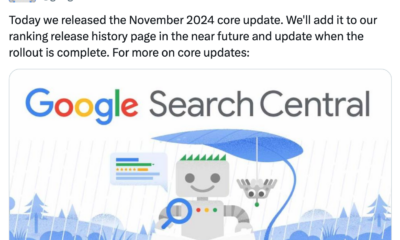MARKETING
AI Tools Bug Out Because the Internet Can Never Forget

The internet never forgets.
That famous meme dates to at least the early 2000s. The digital internet acts as a more permanent version of what philosopher and sociologist Maurice Halbwachs deemed as the “collective memory” in his book of the same name almost 100 years ago. He concludes societies have a collective memory that depends on the framework within which they exist.
Put simply: In groups, both individual and group memories exist. I experience this when a group of my childhood friends remembers me doing things I haven’t the foggiest recollection of doing.
For better and worse, the internet has become society’s collective memory. Unlike a disagreement between friends arising over whose memory is more fallible, the internet doesn’t forget.
For better and worse, the internet has become society’s collective memory, says @Robert_Rose via @CMIContent. Click To Tweet
Over the years, this collective photographic memory has presented interesting challenges for society. Young people recording their – let’s just call it formative – behavior and opinions on social media experience greater challenges than those who did similar things in their youth without the ability to make them part of the collective memory of the internet. The same is true for post-internet companies. People can retrieve almost every word of anything the brand’s ever said in a press release or digital marketing and communications channel.
For example, if you asked me last week if I’d ever given an interview on Fox News, I would laugh and say “no.” But in writing this article, I used the Internet Archive to review a website I wrote in 1998. A press release (that I authored) was right there, highlighting my appearance on a local Fox News TV affiliate talking about this new thing called the “world wide web” and how I believed families, individuals, and companies would build websites in the future.
I forgot all about that interview, but the internet did not.
Photographic memory is a bug, not a feature
In my last weekly CMI News video, I covered the launch of Microsoft’s integration of OpenAI’s ChatGPT into web search. In that story, I also talked about Google’s attempt at newsjacking Microsoft’s announcement and its resulting very bad day.
Google’s bad day stemmed from the AI chatbot returning an inaccurate “fact” that the James Webb Telescope took the first picture of exoplanets (those that lie outside our solar system). In fact, the first telescope to photograph exoplanets did so in 2004.
Did the internet have that information? Yes, of course, it did. Did the internet forget? No.
The internet remembered perfectly. Its memories, though, are inaccurate. Most of the popular search engines (including Google and Bing) returned results with the Webb-did-it-first answer as hundreds of articles from media outlets repeated the same inaccurate conclusion.
The mistake seems to have originated from a NASA release that opened, “For the first time, astronomers have used NASA’s James Webb Space Telescope to take a direct image of a planet outside our solar system.” Say what you will structurally about that sentence – the end result led all those media companies to run with one distinct interpretation of the “fact” – that it was the first time exoplanets had been photographed.
The thing is, when NASA distributed the release in September 2022, almost no one cared about the erroneous interpretation of the sentence. (A few articles contained comments to correct the record or detail the event more precisely.) The internet stored the results in its memory. When an artificial intelligence tool used collective memory to answer a question about the James Webb Space Telescope, it dutifully remembered. Perfectly.
@Google’s Bard AI mistake on the Webb telescope discovery was built on an erroneous interpretation made repeatedly by media five months earlier on the internet, says @Robert_Rose via @CMIContent. Click To Tweet
The internet is our collective memory. The more of us who remember inaccurately, the more likely the collective will do the same.
Forgetfulness is a feature, not a bug
Scientists have long shown the human trait of forgetfulness is a good thing. It helps people prioritize, think better, make better decisions, and be more creative. Human “memory” is not designed to retrieve facts from a database but to help people retain what is valuable to make intelligent decisions. Your brain isn’t broken when you forget something. It often purposely disregards the information to let you focus on retaining more important information, simplifying a concept, or allowing you to find new information about what you already believe you understand.
Think about when you watched a movie for the second time and forgot how great it was or saw it in a new way. Or think about when you say to someone, “What you’re saying doesn’t sound right, but I forget why,” and look up something you feel you should already know.
Humans have the ability to forget irrelevant information. Now, your brains aren’t the perfect judge of what’s irrelevant. Sometimes, they wrongly judge what information is irrelevant. When I forgot something at the grocery store after my wife explicitly asked for it, my brain either decided the request was irrelevant information or it made room for something else (like what I was going to write about for my weekly article). Believe me when I say my juicy rationalization for my forgetfulness is the latter, not the former.
Overall, the flaws in AI – and specifically generative content at this point in its development – demonstrate why forgetfulness can be a feature and one to incorporate into your process. AI designers have their work cut out for them to design systems that can forget and “not know” things so that they can reframe AI learning to understand what information is relevant and irrelevant.
Don’t forget to forget your content
As marketing and communication practitioners, you have your collective memory challenges. Don’t forget your repository of digital content acts like the internet. It, too, never forgets.
AI tools can present an attractive opportunity to learn from your website, digital asset management system, measurement data, CRM platform, etc. One marketing director told me recently they turned an AI chatbot loose on 128,000 documents collected over the years to learn how to suggest and create new content and insights for the marketing team.
That’s a wonderful experiment, but don’t forget (pun intended) that just because you created it, the information can still be inaccurate, irrelevant, or something the brand would rather forget. As you deploy AI-oriented tools, be more mindful of these two things:
1. Remember you are the AI
An AI-based tool predicts a content topic won’t work because of how poorly it performed in the past. The AI dutifully recalls every image, word, and punctuation of the content campaign you long forgot. It remembers how poorly it all turned out.
The AI tool returns answers based on that collective memory. However, while the memory isn’t wrong, you may have been. It’s possible that just like the reporters that misread the NASA release and created hundreds of articles with an inaccurate description, you’ve created tons of messaging, content, analysis, and measurement data based on something just as inaccurate. (The same thinking applies when the AI tool suggests content topics based on positive performances.)
Just because the machine learned correctly doesn’t mean it learned something correct.
2. Remember why people forget things
People forget things to allow room to focus on what’s important. That’s not because they can’t “fit” more information inside their brains; it’s because people’s memories are meant to help them focus on the information that they believe is most important and make better choices.
AI can help develop content based on learning from a perfect collective memory of everything created. But sometimes, forgetting details allows people to see a new forest. Sometimes it’s because you forgot why you loved that old content so much that you could see something familiar in a new way.
If you put all your trust in the photographic memory to write content or suggest creative based mostly on irrelevant or (worse) inaccurate information, you can bet it will always be accurate to what you remembered but never benefit from what you’ve forgotten.
Don’t forget this
Remember, everything relevant is always worth remembering, but remembering everything isn’t always relevant.
Sometimes having some memory loss can be a good thing in making better creative decisions.
It’s your story. Tell it well.
Get Robert’s take on content marketing industry news in just five minutes:
Watch previous episodes or read the lightly edited transcripts.
HANDPICKED RELATED CONTENT:
Cover image by Joseph Kalinowski/Content Marketing Institute













You must be logged in to post a comment Login